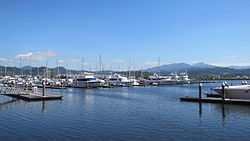
Bataan is a province situated in the Central Luzon region of the Philippines. Its capital is the City of Balanga. Occupying the entire Bataan Peninsula on Luzon, Bataan is bordered by the provinces of Zambales and Pampanga to the north. The peninsula faces the South China Sea to the west and Subic Bay to the north-west, and encloses Manila Bay to the east.

Zambales is a province in the Philippines located in the Central Luzon region in the island of Luzon. Its capital is the Municipality of Iba which is strategically located in the middle of the province. Zambales borders Pangasinan to the north and northeast, Tarlac to the east, Pampanga to the southeast, Bataan to the south and the West Philippine Sea to the west. With a total land area of 3,830.83 square kilometres (1,479.09 sq mi), Zambales is the second largest among the seven provinces of Central Luzon after Nueva Ecija. The province is noted for its mangoes, which are abundant from January to April.
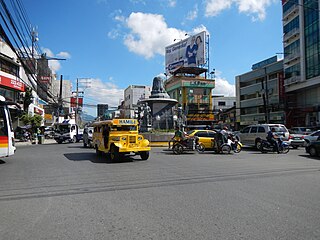
Olongapo, officially the City of Olongapo or simply Olongapo City, is a 1st class highly urbanized city in Central Luzon (Region III), Philippines. Located in the province of Zambales but governed independently from the province, it has a population of 233,040 people according to the 2015 census.
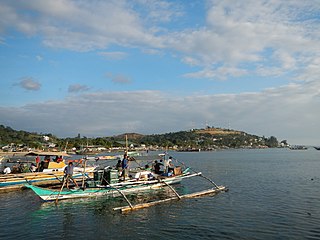
Subic, officially the Municipality of Subic, is a 1st class municipality in the province of Zambales, Philippines. According to the 2015 census, it has a population of 104,771 people.

Subic Bay International Airport or SBIA serves as a secondary airport and a main diversion airport of the Ninoy Aquino International Airport. It is also the airport serving the immediate area of the Subic Bay Freeport Zone, the municipality of Morong, Bataan and the general area of Olongapo in the Philippines. This airport was previously Naval Air Station Cubi Point of the United States Navy.

Richard Juico Gordon, known as Dick Gordon, is a Filipino politician and broadcaster who currently serves as a Senator of the Philippines and the chairman of the Philippine Red Cross.
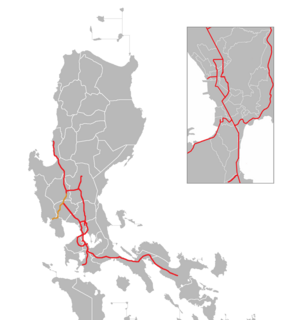
The Subic–Clark–Tarlac Expressway (SCTEx) is a 93.77-kilometer (58.27 mi) four-lane expressway north of Manila, in the Philippines, built by the Bases Conversion and Development Authority (BCDA), a government owned and controlled corporation under the Office of the President of the Philippines. Started on April 5, 2005, the Subic–Clark–Tarlac Expressway (SCTEx) is the country’s longest expressway at 93.77 kilometers (58.27 mi).

Subic Bay is a bay on the west coast of the island of Luzon in the Philippines, about 100 kilometres (62 mi) northwest of Manila Bay. An extension of the South China Sea, its shores were formerly the site of a major United States Navy facility named U.S. Naval Base Subic Bay, which is now the location of an industrial and commercial area known as the Subic Bay Freeport Zone under the Subic Bay Metropolitan Authority.
Ambala is a Sambalic language spoken in the Philippines. It has more than 2,000 speakers and is spoken within Aeta communities in the Zambal municipalities of Subic, San Marcelino, and Castillejos; in the city of Olongapo; and in Dinalupihan, Bataan (Ethnologue).

The Port of Subic Bay is in the Subic Bay Freeport Zone, the former U.S. Naval Base Subic Bay, on Subic Bay in the Philippines. It is one of the busiest, largest, historical and most important of ports in the Philippines. The Port is operated and managed by the Subic Bay Metropolitan Authority (SBMA).
Regional Science High School III is a science high school located in East Kalayaan, Subic Bay Freeport Zone, Olongapo City, Zambales province of the Philippines. The school implements a specialized science and mathematics-oriented curriculum, mainly for academically strong adolescents and was established in 1994. RSHS III houses a junior high school and a STEM strand focused senior high school. Most of the student body are residents of nearby cities & provinces, majority of whom are from Olongapo City, Bataan and Zambales.

DWSB, broadcasting as 89.5 Subic Bay Radio, is a public radio facility of the Subic Bay Metropolitan Authority. The station's studio and transmitter are located at Bldg. N, Quezon Street, Subic Bay Freeport Zone, Olongapo City.

Naval Base Subic Bay was a major ship-repair, supply, and rest and recreation facility of the Spanish Navy and subsequently the United States Navy located in Zambales, Philippines. The base was 262 square miles, about the size of Singapore. The Navy Exchange had the largest volume of sales of any exchange in the world, and the Naval Supply Depot handled the largest volume of fuel oil of any navy facility in the world. The naval base was the largest overseas military installation of the United States Armed Forces after Clark Air Base in Angeles City was closed in 1991. Following its closure in 1992, it was transformed into the Subic Bay Freeport Zone by the Philippine government.
Harbor Point is a shopping mall in Subic Bay Freeport Zone in Olongapo City, Zambales, Philippines owned by property development firm Ayala Land, Inc., a real estate subsidiary of Ayala Corporation. It is the first Ayala mall located in Subic Bay, second in Central Luzon and the fourth outside Metro Manila.

Bataan National Park is a protected area of the Philippines located in the mountainous interior of Bataan province in the Central Luzon Region. The park straddles the northern half of Bataan Peninsula near its border with Subic Bay Freeport Zone, Zambales. The park was first established in 1945 under Proclamation No. 24 with an initial area of 31,000 hectares and included portions in Subic, Zambales. The park was reduced in 1987 to its present size of 23,688 hectares and is now wholly located in Bataan province. The park encompasses the Bataan towns and cities of Hermosa, Orani, Samal, Abucay, Balanga, Bagac and Morong.
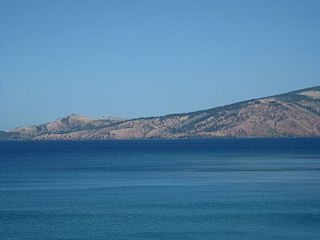
The Redondo Peninsula is a short mountainous peninsula extending about 15 kilometers to the south of Zambales on western Luzon in the Philippines. It separates Subic Bay and the coasts around the Subic Bay Metropolitan Area of Subic and Olongapo from the South China Sea. It is known for its secluded coves, beaches and pine-forested mountains.
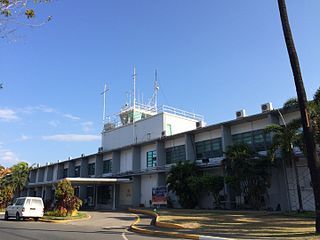
The Subic Bay Metropolitan Authority is governmental agency of the Philippine government. Sometimes abbreviated as SBMA, the agency has played a significant part in the development of the Subic Bay Freeport and the Special Economic Zone into a self-sustainable area that promotes the industrial, commercial, investment, and financial areas of trade in the zone as well as in the country of the Philippines itself.
New Clark City is a planned community under development located in Capas, Tarlac, Philippines. It has an area of approximately 9,450 hectares and will accommodate up to 1.2 million people. It is managed by the Bases Conversion and Development Authority (BCDA). NCC is patterned after the development of Putrajaya, the federal administrative capital of Malaysia.

The Jose Abad Santos Avenue, also known as Olongapo–Gapan Road and Gapan–San Fernando–Olongapo Road is a 118-kilometer (73 mi) major highway spanning the provinces of Nueva Ecija, Pampanga, Bataan and Zambales in Central Luzon, Philippines. The highway is designated as the National Route 3 (N3) of the Philippine highway network.

The Freeport Area of Bataan (FAB), formerly Bataan Export Processing Zone (BEPZ) from 1972 to 2010, is a special economic zone in Mariveles, Bataan, Philippines. It was envisioned by Congressman Pablo Roman, Sr., a representative from Bataan, who authored Republic Act 5490 designating the said location as the first free trade zone in the Philippines.
